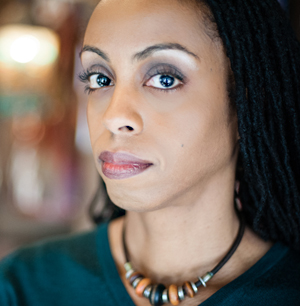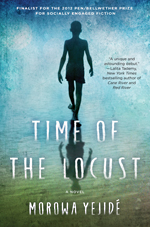 Kalamazoo College alumna Morowa Yejidé ’92 is a nominee for a 2015 NAACP Image Award to be awarded Friday, February 6, in Los Angeles. She is nominated in the category of Outstanding Literary Debut Work for her first novel Time of the Locust, described as a deeply imaginative journey into the heart and mind of an extraordinary boy that explores the themes of a mother’s devotion, a father’s punishment, and the power of love.
Kalamazoo College alumna Morowa Yejidé ’92 is a nominee for a 2015 NAACP Image Award to be awarded Friday, February 6, in Los Angeles. She is nominated in the category of Outstanding Literary Debut Work for her first novel Time of the Locust, described as a deeply imaginative journey into the heart and mind of an extraordinary boy that explores the themes of a mother’s devotion, a father’s punishment, and the power of love.
Time of the Locust (hardcover, 256 pages, Atria Books) is also included in Simon & Schuster’s Freshman Year Reading Catalog for 2014-2015, and was a finalist for the 2012 PEN/Bellwether Prize for socially engaged fiction.
The story revolves around Sephiri, a 7-year-old autistic boy who can draw scientifically accurate renderings of prehistoric locusts but never speaks, smiles, or makes eye contact.
Dara Morowa Yejide Madzimoyo is an accomplished writer whose short stories have appeared in the Istanbul Review, Ascent Aspirations Magazine, Underground Voices, Adirondack Review, and other publications. Her story “Tokyo Chocolate” was nominated in 2009 for a Pushcart Prize and was anthologized in the Best of the Willesden Herald Stories.
 Morowa earned her B.A. degree from K in international area studies and her M.F.A. degree in creative writing from Wilkes University, in Wilkes-Barre, Pa., where she received the Norris Church Mailer Scholarship.
Morowa earned her B.A. degree from K in international area studies and her M.F.A. degree in creative writing from Wilkes University, in Wilkes-Barre, Pa., where she received the Norris Church Mailer Scholarship.
She is a research faculty member at Georgia Institute of Technology and an adjunct faculty member at the University of Maryland. Now based in Washington, D.C., Morowa and her husband have three sons.
Recently, she was selected as “Independent Alum of the Day” by the Michigan College’s Alliance, a collective of 15 independent colleges and universities located throughout Michigan.









